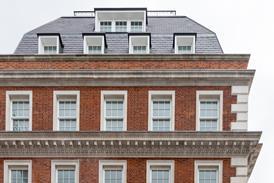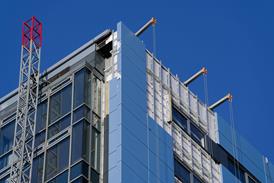Northern Ireland’s gas supplier didn’t want to have to pay astronomical energy bills, fall behind and end up suing itself for its own money. Cartwright Pickard Architects and QS Gardiner & Theobold explain how the team managed to avert this fate by delivering a building that not only achieved a BREEAM “very good” rating, but was also significantly cheaper than comparable offices in Belfast
<B>
Phoenix Natural Gas HQ
</b><B>Project</b>
Main operational facility for Phoenix Natural Gas supply company
<B>Location</b>
Sydenham Business Park, close to Belfast’s City Airport
<B>Awards</b>
Shortlisted for British Council of Offices award 2002; Bovis project manager Malachy Martin won CIOB Building Manager of the Year 2002 for projects under €15m.
<B>Low-energy design features</b>
- “Very good” BREEAM rating
- Mixed-mode environmental control system, combining displacement floor ventilation and natural cross-ventilation
- Energy load reduced by external sunshading, exposed concrete floor soffits, good insulation, large window areas and night-time cooling
<B>Architectural design features</b>
- Contemporary, efficient appearance
- Flexible floor plans to accommodate both open-plan and cellular layouts
<B>Cost features</b>
- Total construction cost of £5,066,234 for 4776 m2 gross internal floor area, including category B tenant’s fit-out and landscaping
- Unit construction cost of £1061/m2 is 12-39% cheaper than comparable office buildings in Belfast
<B>Construction period</b>
14 weeks
<B>Procurement</b>
Construction management
<B>
Client’s brief
</b>The building was developed by British Gas Property for Phoenix Natural Gas, a subsidiary of the BG group and Northern Ireland’s only natural gas supplier. During the project, the developer demerged from the group and changed its name to Lattice Property Holdings, severing all corporate connections with the tenant.
The special relationship of developer and tenant gave the project a dual brief. The building had to answer the specific accommodation needs of Phoenix Natural Gas while providing a general-purpose office building that could be let on the open market. Added to that, Phoenix has a special status as a government-regulated company, which put a premium on the cost-effectiveness of the development.
Phoenix Natural Gas wanted to relocate staff from four sites to a purpose-designed operations centre at a business park near Belfast Airport. The objective was to satisfy the demands of individual departments and boost efficiency by making day-to-day operations more effective.
Phoenix’s brief for the new building called for environment-conscious design to create a pleasant, temperate atmosphere that would be both comfortable for staff and economical to run.
The company planned to house a wide variety of tradespersons and professionals in the new building, each with their own demands on the design and operation of the building. For this reason, effective space planning was critical so that the operation of the business would shape the layout, not vice versa.
<B>
Architectural design features
</b>The building has a bright and modern appearance, as it is flooded with natural light during the day and glows attractively at night. The bright image is clearly visible on the approach to the site and is enhanced by high-quality landscaping, as car parking has been relegated to the rear of the site.
The staircase rises from the front entrance to give spectacular views over the shores of Belfast Lough towards Belfast. The form of the building, the front canopies and the strong horizontal emphasis of the curtain walling all reinforce the architectural relationship to the waterfront.
The interiors are planned to encourage interaction among staff and communication between departments. Flexible floor plans accommodate open plan areas, meeting rooms for strategic planning and open meeting spaces at the heart of each floor.
The central atrium space is served by a kitchen/restaurant that provides a social focus for the building.
<B>
Low-energy design features
</b>The building has fully integrated the use of daylight, natural ventilation, high levels of insulation and thermal mass to achieve a BREEAM “very good” rating. Only the lack of public transport close to the site prevented the scheme from being awarded an “excellent” rating. These factors and the use of highly efficient gas-fired boilers and heat-recovery devices also help to minimise emissions of carbon dioxide.
About 50% of the building envelope is glazed to achieve an economic balance between heating and cooling costs and savings in electric lighting. The glazed facades are fitted with sunscreens to shade the building in summer while admitting winter sunlight at lower angles to offset heat losses.
Although windows can be opened by occupants, the proximity of the building to Belfast City Airport could create noise problems. A mixed-mode displacement ventilation system combines natural cross-ventilation through the windows with mechanical ventilation supplied through floor grilles, supplemented by comfort cooling if required.
Concrete floor slabs with exposed soffits and a high level of thermal insulation in the building envelope dampen internal temperature swings and hence the heating and cooling loads. In summer, natural cooling is provided by the thermal mass of the exposed floor slabs combined with night-time purging of cool fresh air by mechanical ventilation using cheap off-peak electricity. In winter, heat exchangers preheat the fresh air.
Floorplates measuring 15 m between external glazed facades allow effective natural cross-ventilation and admit plentiful daylight. Light sensors and detectors of movement within the building cut down on unnecessary artificial lighting.
<B>
Cost and procurement
</b>Lattice Property Holdings has used construction management to procure numerous projects of this nature throughout the UK, and it has found the system to be an amicable arrangement that gives sufficient flexibility and control. For the Phoenix project, Bovis Lend Lease was appointed at a very early stage to provide pre-construction advice. Bovis set out to encourage a project-focused approach to problem-solving that, in this case, made for a highly motivated, non-adversarial team.
Gardiner & Theobald prepared a pre-contract cost plan using an in-house estimating system based on the scope of the work packages that it and Bovis Lend Lease envisaged. This cost plan formed the backbone of the overall project budget. In order to maximise the cost benefits to the client, each works package was competitively tendered using detailed drawings, specifications and schedule of
works. This approach was adopted in order to assist with tender appraisal, valuations and the cost assessment of post-contract variations.
G&T’s cost management system, coupled with monthly meetings with the construction manager, kept the project team and the client well informed of cost developments during the course of the works. Cost control was made easier by the fact that both G&T and Bovis submitted monthly cost reports in parallel.
Projects of this size, including specification and configuration, range in budgeted value from £1200 to £1750 per m2 in Northern Ireland.
The team for this project fully met the client’s design brief and brought an ambitious scheme within their budget. Final unit construction cost, including category B tenant’s fit-out and landscaping came out at £1061/m2.
<B>
The specialist’s view
</b><B>Professor Brian Norton, dean of the faculty of engineering and built environment, University of Ulster</b>
Electricity prices in Northern Ireland are the highest in the UK. Energy costs are thus an important issue for the province’s building owners and operators. The two most timely aspects of reducing energy costs for most building operators in Northern Ireland are the introduction of natural gas and the need to achieve more efficient use of energy. It is therefore perhaps singularly appropriate that Phoenix Gas – Northern Ireland’s first and only provider of piped natural gas – is now headquartered in an exemplary landmark low-energy office building.
The Phoenix Natural Gas headquarters should emit, at most, about 25% of the CO2 emissions per square metre of a typical office building in Belfast. More than that, its unit construction cost of £1061/m2 is lower than the recent spate of comparable new buildings in Belfast. This building therefore squares the circle of achieving both environmental sustainability and economic viability and lays down a clear benchmark for others to challenge.
Downloads
Sections
Other, Size 0 kb
Credits
Client
Lattice Property Holdings
ArchitectCartwright Pickard Architects
Structural and services engineer
Whitby Bird & Partners
Quantity surveyor
Gardiner & Theobold
Landscape architect
EDC
Construction manager/planning supervisor
Bovis Lend Lease
Curtain walling
CEP Arcal/Technal
Steelwork
SC Graham
Metalwork
Pressfold
M&E contractor
The Harvey Group
Partitions/raised floor
Drew Wylie Building Services
Concrete
Creagh Concrete






















